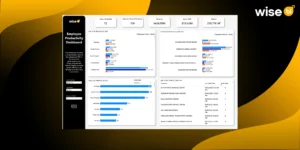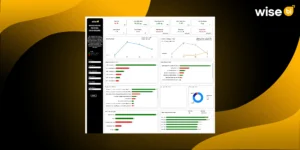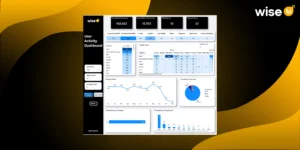The ability to track and record all shipments, especially for people who use CargoWise for managing complicated logistics, is very important. In other words, a Performance BI Dashboard is a single platform solution for the effective monitoring of business processes and decision-making. Whether the transport means to be used is air, sea, road, or rail transport, there must be a hub that would facilitate efficiency, less trouble, and optimum cost. Here is an urgent need for such a dashboard and the value it brings to those who cater to it.
The Necessity of Shipment Analysis
Shipment analysis can, therefore, be seen as a vital part of effective supply chain management. It includes real-time monitoring of the shipment, the identification of constraints, and the examination of data to make the process more effective. Inadequate analysis may lead to the inability of the logistics teams to manage issues such as delays, excess costs, and distribution of resources. For the CargoWise users, there is an availability of the Performance BI Dashboard through which there is real-time tracking so that no freight transport mode and each of the shipments transported is tracked to achieve speed and economical value.
Features of a Performance BI Dashboard
- Real-Time Data Visualization: One of its primary features is the real-time tracking of shipment, the dashboard is used to display metrics in real-time. This helps in addressing any interruption that may occur so that regularity is restored as soon as possible.
- Customizable Dashboards: It is also possible to modify the dashboard with the most necessary information for the user. Despite covering air freight, road transport, or a complete supply chain, the various settings make sure that the most crucial information is always available.
- Advanced Reporting: The dashboard provides tools for reporting that focus on shipment tendencies and delays as well as cost fluctuations. These realizations assist the logistics teams in determining the patterns and problems making it easy to improve the process flow.
- Multi-Mode Tracking Integration: This way, the shippers can monitor goods transport across various means of transport such as air, sea, road, and rail in one comprehensive platform. This helps in effective supervision and synchronization of all the shipment processes in place.
Key Performance Indicators (KPIs) in Shipment Tracking
- On-Time Delivery Rate: This KPI measures how many shipments are delivered within the specified time agreed with the customers. On-time delivery plays a central role in keeping the customers happy and in the efficient running of the business.
- Transit Time: This calculates the time it takes for shipments to be transported from the point of origin to the point of destination. Measuring transit times are ideal because they provide managers with an opportunity to notice some of the issues that might be hindering the overall efficiency of the transportation system especially areas that may be associated with inefficiencies, delays, or even obstacles.
- Cost Per Shipment: This KPI affords an examination of the overall cost of moving goods, spurting fees including freight charges, handling fees, and other expenses. Tracking cost per shipment aids in managing the logistics expense and analysing the savings that can be made.
- Shipment Accuracy: Shipment accuracy entails the ability of a firm to deliver goods without any damages, with the right quantities, and at the right delivery points. It makes certain that customers receive their orders as stipulated thus reducing cases of returns or having to make additional adjustments.
- Resource Utilization: This KPI measures the extent to which resources like trucks, containers, or warehouse space are being utilized. When properly implemented and managed, such resources will not be wasted, but will instead improve the general functioning of companies, thereby cutting down costs.
Challenges Faced Without a Performance BI Dashboard
- Lack of Real-Time Data: As for the lack of real-time data, logistics firms find themselves in a simple question-response process, where they only tackle issues as and when they happen. Such a delay in the availability of shipment information may consequently diminish the chance to address concerns promptly and also reduce efficiency.
- Data Fragmentation: Generally, shipment data is stored across multiple systems and modes of transport, and without consolidation, it is not possible to get a holistic view of the performance. This fragmentation makes it difficult in the decision-making process, and responses are also slower.
- Limited Visibility: Coordinating different transport forms including air and sea freight, road, and rail transport, and using a single platform to track shipment becomes difficult. The lack of an integrated environment does not allow for tracking shipment status and may result in delays or failures.
- Inefficient Resource Allocation: If the decisions are not based on correct data then the logistics departments are in a fix about how to allocate resources such as trucks, containers, and people. Excessive usage or underutilization of such centers may lead to high operational costs and thus low organizational efficiency.
Benefits of Implementing a Performance BI Dashboard
The implementation of the Performance BI Dashboard brings many benefits to CargoWise users. A major advantage is enhanced visibility that allows for the monitoring of all shipment modes inclusive of air, sea, road, and rail in one platform. This visibility enables the logistics firms to monitor the shipment and ensure that it is not held or delayed in any way. Real-time is also approved for upgrading decision-making because one is capable of tackling an issue as it unfolds and, therefore, can work to allocate assets in the proper areas.
The dashboard also assists in resource analysis whereby the underutilized resources in the organization can be easily noticed thus reducing costs and increasing efficiency. The identification of suspicious activities minimizes operations’ costs which, together with timely management of possible risks, prevents disruptions.
Conclusion
For CargoWise users tracking multi-modal shipments, using the Performance BI Dashboard is ideal. It can be utilized for tracking shipments with features such as real-time data provision, customized dashboards, and robust reporting for enhancing every phase of the operation. Using on-time delivery, transit time, and the use of resources as KPIs, it is easy for businesses to track supply chain performance, and tackle any challenge or hurdle before it reaches the supply chain.
Would you like to benefit from the Performance BI Dashboard, which can lower costs, improve decision-making and visibility, and assist supply chain management across all modes of transportation? To learn more, get in touch with Wise BI right now.



